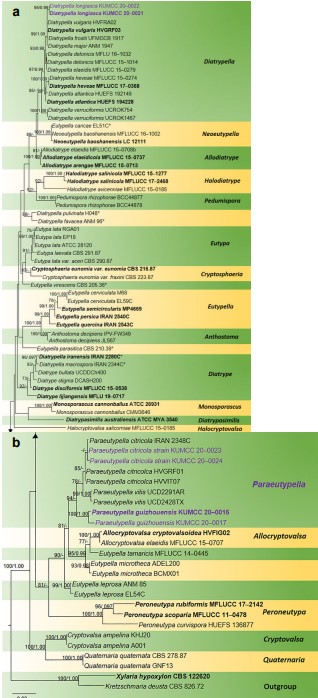Paraeutypella L.S. Dissan., J.C. Kang, Wijayaw. & K.D. Hyde, in Dissanayake, Wijayawardene, Dayarathne, Samarakoon, Di, Hyde & Kang, Biodiversity Data Journal 9: e63864, 11 (2021)
Index Fungorum number: IF 557954; Facesoffungi number: FoF 09231
Etymology – With reference to the morphological resemblance to Eutypella.
Saprobic on dead twigs. Sexual morph: Stromata immersed in bark of dead branches, erumpent, solitary or aggregated. Ascomata with groups of 4–25 perithecia arranged in a valsoid configuration, surrounded by white, powdery entostroma, perithecial, black or brown, subglobose, clustered, immersed in stromata. Necks papillate, with an elongated ostiolar neck, central ostiolar canal filled with periphyses, 3–6 sulcate. Peridium composed of two layers of cells of textura angularis; inner layers cells hyaline or light brown, outer layers cells dark brown to black. Hamathecium composed of paraphyses arising from the base of perithecia, elongate, filiform, narrow, unbranched, septate, guttulate, narrowing and tapering towards apex. Asci 8-spored, unitunicate, thin-walled, clavate to cylindrical clavate or spindle-shaped, long pedicellate, apical rings J-. Ascospores overlapping biseriate, allantoid, slightly to moderately curved, allantoid, several oil droplets in each end, hyaline to light brown, sometimes yellow in mass, aseptate. Asexual morph: Coelomycetous. Conidiomata black, subconic, multiloculate, largely prosenchymatous, producing yellowish conidial masses. Conidiophores not recorded. Conidiogenous cells cylindrical, tapering, arising from pseudoparenchyma or interwoven hyphae, proliferating percurrently or sympodially, rarely both ways. Conidia hyaline, single-celled, slightly to moderately curved, with flattened bases, becoming guttulate (description of asexual morph adapted from Glawe and Jacobs 1987).
Type species – Paraeutypella guizhouensis L.S. Dissan., J.C. Kang & K.D. Hyde
Notes – Paraeutypella is introduced to accommodate three species, viz., P. guizhouensis sp. nov., as well as P. citricola and P. vitis, two species previously placed in Eutypella sensu lato. Paraeutypella is typified by P. guizhouensis, which was collected from undetermined dead twigs. Paraeutypella can be distinguished from Eutypella species by stromata with perithecia in groups of 4–25 arranged in a valsoid configuration, 3–6 sulcate, long ostiolar necks, while stromata of Eutypella comprise groups of 20–70 perithecia having comparatively shorter ostiolar necks with sulcate or smooth ostiolar necks. Strains of both genera appear in distinct clades in a phylogeny based on ITS and Beta tubulin data (Fig. 1), thereby justifying the erection of the new genus Paraeutypella. However, sequence data are not available for the type of P. citricola and P.vitis. A coelomycetous asexual morph has been recorded for P. vitis as Eutypella vitis in culture (Glawe and Jacobs 1987).

Figure 1.
Phylogram generated from Maximum Likelihood (RAxML) analysis, based on ITS- β-tubulin matrix. ML bootstrap supports (≥ 70%) and Bayesian posterior probability (≥ 0.95) are indicated as ML/BYPP. The tree is rooted to Kretzschmaria deusta (CBS 826.72) and Xylaria hypoxylon (CBS 122620). Newly-generated strains are in red and type strains are in bold. The asterisks represent unstable species.
Species
